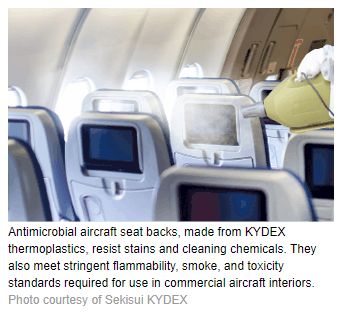Welcome to Sino Bearings web
24x7 HOTLINE:+86-28-81454188

 NEWS
NEWS
1. Using antimicrobial plastics that have enhanced compatibility with disinfectants for aircraft interiors.
Due to the COVID-19 pandemic, aircraft interior surfaces are being cleaned and disinfected in ways that can quickly degrade traditional plastic materials. New antimicrobial and disinfectant-resistant plastics initially developed for use in hospitals are now being specified for aircraft interiors. These materials are formulated to meet the stringent flame, smoke, toxicity, and heat-release standards required for commercial aircraft.
2. Specifying high-strength thermoplastic composites for weight savings, improved fuel efficiency.
Aerospace structures requiring high strength and stiffness have traditionally been made from metals or thermoset composites. However, these materials have some significant limitations. Metals are heavy, limiting their use for aerospace applications where light weight is desired. Thermoset composites tend to be brittle, often having poor chemical resistance. Thermoset manufacturing is labor-intensive, with most thermoset composite materials not suitable for temperatures above 100°C.
A new class of thermoplastic composites developed by Ensinger has strength and modulus (stiffness) values comparable to metals and thermosets. The technology involves continuous glass fibers or carbon fibers embedded in a thermoplastic polymer matrix, usually consisting of polyetheretherketone (PEEK) or Ultem PEI (polyetherimide). Since the matrix is made from high-performance, thermally stable plastics, these composites can be used at elevated temperatures.
Thermoplastic composites offer many advantages associated with thermoplastics including ductility, fatigue resistance, and vibration damping characteristics, as well as resistance to fuels, lubricants, and cleaning chemicals. Sheet stock made from these materials can be quickly formed into finished parts using heated metal tooling, lowering manufacturing costs.
3. Choosing plastics that don’t interfere with radio frequency (RF) signals for high-performance communications radomes.
The proliferation of unmanned aerial vehicles (UAVs), drones, and satellites that rely on RF signals to control flight operations has increased demand for highly reliable antennas. Optimum antenna function requires plastic radomes that won’t significantly attenuate RF signals at the desired frequency and throughout the device’s operating temperature range. Specialized engineering plastics with low dielectric constants and low dissipation factors as well as enhanced toughness, ultra-violet (UV) resistance, and thermoformability are becoming more widely specified for use as protective antenna radomes.
4. Selecting durable, high temperature plastics to separate metal surfaces for improved reliability.
Metal-to-metal connections are often points of failure in aircraft assemblies due to inherent problems when mated metal surfaces are subjected to vibration and/or sliding wear. Increasingly, designers are specifying ductile, high-performance polyimide materials for applications such as spline couplings and the anti-rotation elements of locking fasteners to separate metal parts. Introducing the polymer element into the assembly increases service life and extends time between required maintenance cycles.
For spline connections that transmit power to various aircraft systems through connected rotating metal shafts, high-temperature couplings made from DuPont Vespel polyimide are installed between mating metal splines for smoother operation and longer life. The approach reduces spline wear when the rotating metal shafts are slightly misaligned. Ductility of the polymer allows for shaft misalignment without creating excessive stress on the metal shafts, bearings, or drive motors.
In aerospace locking fasteners, DuPont Vespel polyimide is used as a ductile locking element in a nut or a bolt to prevent unwanted rotation without damaging the mating metal fastener during assembly or disassembly for maintenance. This polymer element prevents the galling associated with all metal locking fastener designs.
For both examples, ductility and wear performance of the polymer mitigates problems associated with metal- on-metal contact.
5. Opting for low flammability, high dielectric strength plastics for electrical insulation.
Plastics have long been the prefered material for applications requiring electrical insulating properties. Electrical systems for modern military and civilian aircraft can be particularly challenging since – in addition to having good dielectric strength and resistance to electrical arcing – polymer insulators must be resistant to aircraft fuels and lubricants; withstand vibration, wear, and fatigue; and have outstanding flammability properties. Plastic insulators in aircraft may also have to operate throughout a broad temperature range – from extremely cold at cruising altitudes to extremely hot near jet engines.
Aircraft electrical system designers are now specifying fluoropolymers such as polytetrafluoroethylene (PTFE), fluorinated ethylene propylene (FEP), and perfluoroalkoxy alkanes (PFA) as well as high performance thermoplastics including PEEK, Ultem PEI, and DuPont Vespel for demanding aerospace electrical applications including standoff insulators, shrink tubing, and flexible wire wrap insulation.
6. Employing innovative polymers to create upscale aircraft interiors.
Commercial aircraft are becoming increasingly more upscale, with interiors rivaling luxury hotel lobbies. Printed graphics have traditionally been problematic for aircraft interiors since high-traffic areas are exposed to wear and repeated cleaning that can quickly degrade printing.
Newer technologies such as Infused Imaging with KYDEX thermoplastics allow designers to create customized environments using imagery that’s in the material not on it.
There have also been significant advances in the plastic lens material used to manage and transmit light on commercial aircraft. New polymer formulations allow for high light transmission, excellent diffusion, and precise color control of LED lamps. Light management using high-performance plastics is positively impacting the aesthetics of aircraft interior spaces.